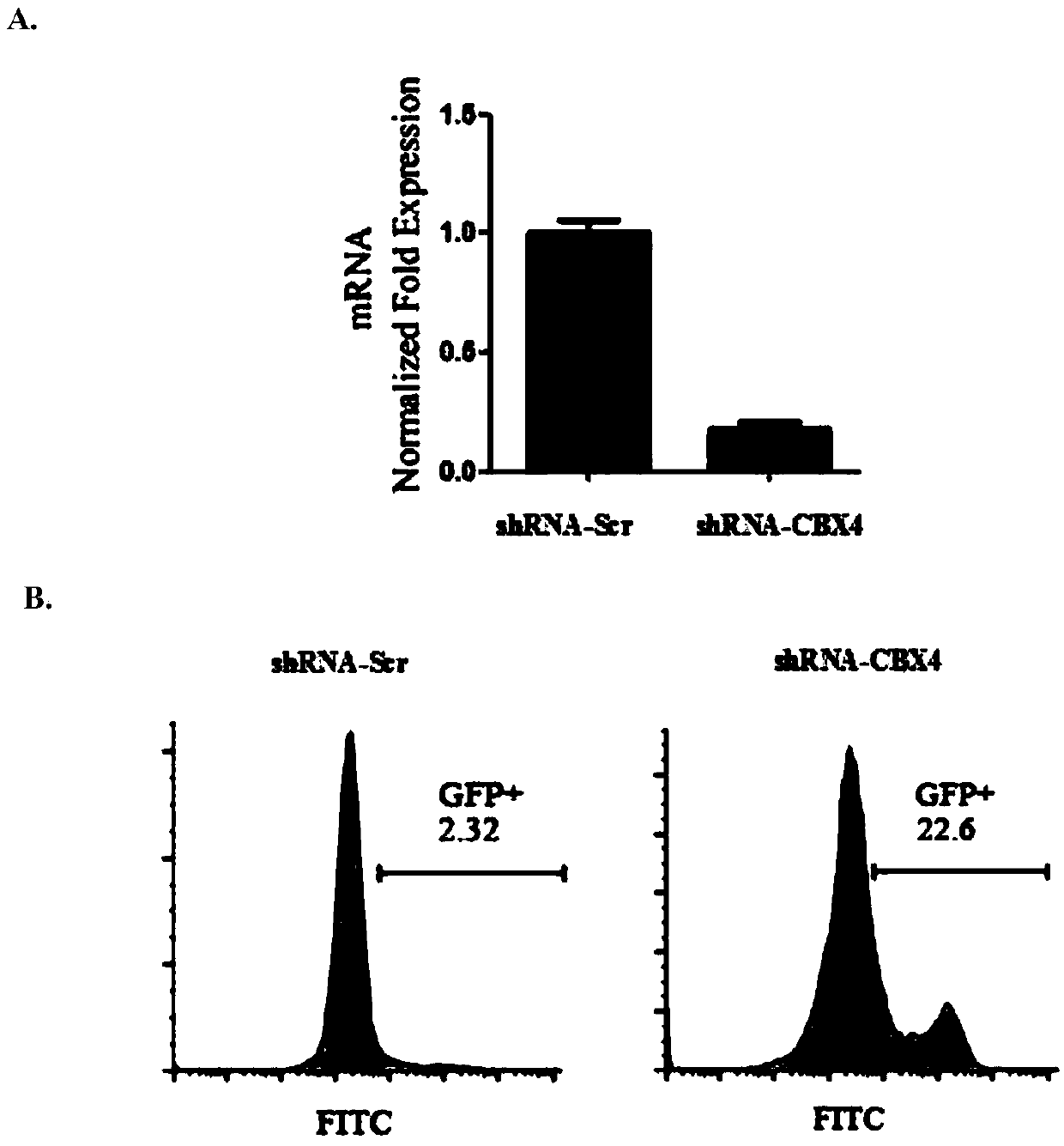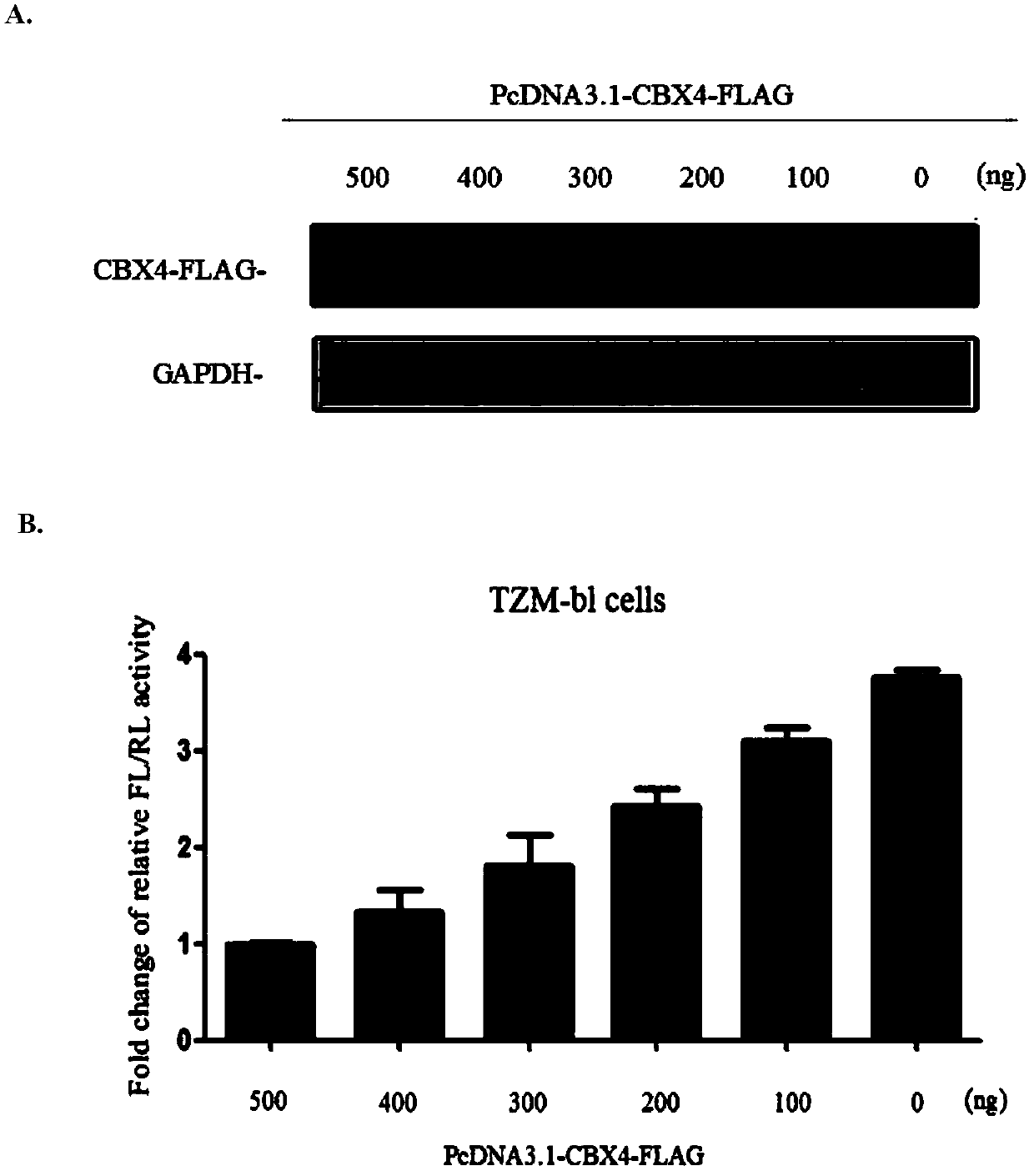Application of CBX4 used as HIV-1 latent infection activation target
A latent infection, HIV-1 technology, applied to medical preparations containing active ingredients, antiviral agents, pharmaceutical formulas, etc., can solve the problems of undisclosed CBX4 and other issues
- Summary
- Abstract
- Description
- Claims
- Application Information
AI Technical Summary
Problems solved by technology
Method used
Image
Examples
Embodiment 1
[0018] Knocking down the expression of CBX4 gene can effectively promote the transcriptional activity of HIV-1 LTR, the specific experimental method is as follows:
[0019] (1) Take well-grown TZM-bl cells and seed them in 24-well plates. The medium used is a complete medium: high-glucose DMEM, 10% fetal bovine serum and 1% double antibody, and the culture condition is 5% carbon dioxide, 37°C;
[0020] (2) After 24 hours of adherence, co-transfect the pcDNA3.1-Tat plasmid and siRNA-CBX4 or siRNA-NC, respectively, and continue to culture under the conditions of 1);
[0021] (3) After 48 hours, collect the cell pellet, take a part of it and use the Trizol method to extract RNA, reverse to obtain cDNA, use CBX4-specific Q-PCR primers to detect the mRNA expression level of CBX4, and determine the knockdown efficiency of siRNA-CBX4;
[0022] (4) The remaining cells were taken, and after lysing, the transcriptional activity of HIV-1 LTR in different transfection treatment groups wa...
Embodiment 2
[0026] Inhibition of CBX4 in J-lat 10.6 HIV-1 latently infected cells effectively activates the HIV-1 latent infection reservoir, the specific experimental method is as follows:
[0027] (1) Synthesize the specific base sequence, anneal to construct the shRNA targeting CBX4, PLKO.1-CBX4, and confirm the correct sequence by sequencing.
[0028] (2) Take the well-grown human epi-renal cell line 239T cells and inoculate them in a 10cm flat-bottomed plate. The medium used is a complete medium: high-glucose DMEM, 10% fetal bovine serum and 1% double antibody, and the culture condition is 5% carbon dioxide, 37°C;
[0029] (3) After 24 hours of adherence, transfect PLKO.1-CBX4 or PLKO.1-NC and psPAX2, VSV-G into the cells, and continue to culture as in 2);
[0030] (4) After 48 hours, collect the supernatant, use PEG-6000 to concentrate the virus particles, and use the ELISA P24 kit to detect virus P24;
[0031] (5) Take the well-grown J-lat10.6 cells, count them, and infect them w...
Embodiment 3
[0038] Overexpression of CBX4 protein in TZM-bl cells can inhibit the transcriptional activity of LTR of HIV-1, the specific experimental method is as follows:
[0039] (1) Order the CBX4 cDNA plasmid template, design appropriate primers, and construct the CBX4 overexpression plasmid, pcDNA3.1-CBX4-FLAG;
[0040] (2) Spread well-grown TZM-bl cells in a 6-well transparent plate, 1×106 cells per well, the medium used is complete medium: high-glucose DMEM, 10% fetal bovine serum and 1% double antibody, The culture conditions are 5% carbon dioxide, 37°C;
[0041] (3) After 24 hours of attachment, transfect the pcDNA3.1-CBX4-FLAG plasmid, and continue to culture as in 2);
[0042] (4) After 48 hours, collect the cells, use RIPA lysate to lyse the cells, and detect the overexpression level of CBX4 by western blot to determine the effect of the pcDNA3.1-CBX4-FLAG overexpression plasmid;
[0043] (5) Spread well-grown TZM-bl cells in a 24-well transparent plate, 1×105 cells per well...
PUM
 Login to View More
Login to View More Abstract
Description
Claims
Application Information
 Login to View More
Login to View More - R&D
- Intellectual Property
- Life Sciences
- Materials
- Tech Scout
- Unparalleled Data Quality
- Higher Quality Content
- 60% Fewer Hallucinations
Browse by: Latest US Patents, China's latest patents, Technical Efficacy Thesaurus, Application Domain, Technology Topic, Popular Technical Reports.
© 2025 PatSnap. All rights reserved.Legal|Privacy policy|Modern Slavery Act Transparency Statement|Sitemap|About US| Contact US: help@patsnap.com



